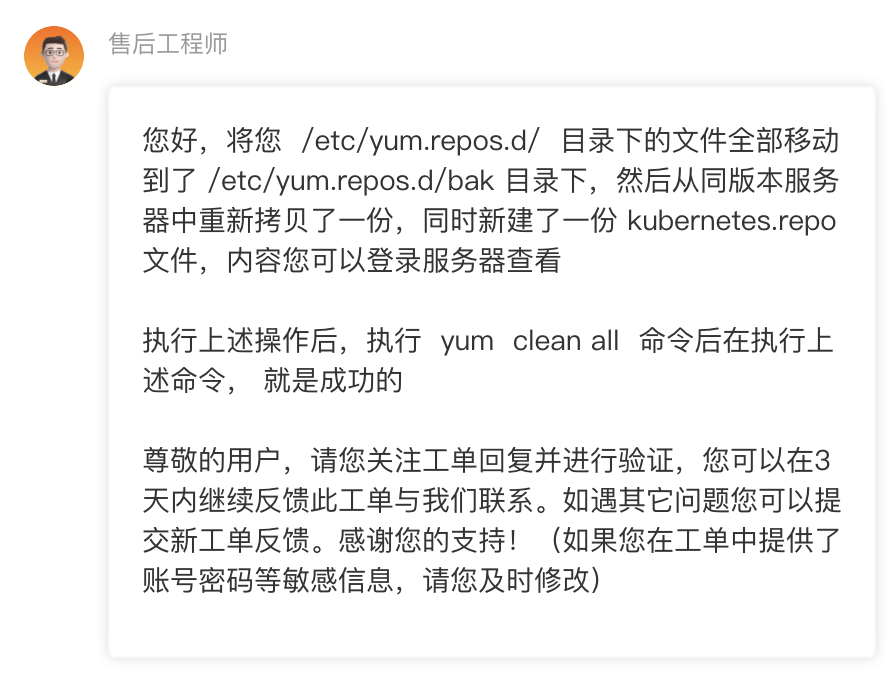1. 安装前的准备工作
# 关闭防火墙
systemctl stop firewalld
systemctl disable firewalld
# 查看hostname并修改
hostname # 查看本机hostname
hostnamectl set-hostname k8s-master # 把本机名设置成k8s-master
hostnamectl status # 查看修改结果
echo "127.0.0.1 $(hostname)" >> /etc/hosts # 修改hosts文件
# 关闭selinux(linux的安全机制)
sed -i 's/enforcing/disabled/' /etc/selinux/config
setenforce 0
# 关闭swap(关闭内存交换)
swapoff -a
sed -ri 's/.*swap.*/#&/' '/etc/fstab'
free -m # 检查,确保swap里面没有东西
# 配置桥接流量
cat <<EOF | sudo tee /etc/modules-load.d/k8s.conf
br_netfilter
EOF
cat <<EOF | sudo tee /etc/sysctl.d/k8s.conf
net.bridge.bridge-nf-call-ip6tables = 1
net.bridge.bridge-nf-call-iptables = 1
EOF
# 生效
sudo sysctl --system
2. docker安装
省略。。。。
3. 安装k8s
# 配置k8s的yum源
cat <<EOF > /etc/yum.repos.d/kubernetes.repo
[kubernetes]
name=Kubernetes
baseurl=https://mirrors.aliyun.com/kubernetes/yum/repos/kubernetes-el7-x86_64
enabled=1
gpgcheck=1
repo_gpgcheck=1
gpg_key=http://mirrors.aliyun.com/kubernetes/yum/doc/yum-key.gpg http://mirrors.aliyun.com/kubernetes/yum/doc/rpm-package-key.gpg
EOF
# 卸载旧版本
yum remove -y kubelet kubeadm kubectl
# 查看可以安装的版本
yum list kubelet --showduplicates | sort -r
# 安装kubernetes
yum install -y kubelet kubeadm kubectl
# 设置开机启动kubelet
systemctl enable kubelet
# 启动kubelet
systemctl start kubelet
# 查看kubelet状态
systemctl status kubelet # kubelet进入无限死循环状态
如果执行安装kubelet失败。可能是我阿里云的yum源配置有问题,我联系了阿里云的售后,他帮我解决了。
4. 配置master节点
# 查看kubeadm需要下载的镜像
kubeadm config images list
## 需要下载的镜像
k8s.gcr.io/kube-apiserver:v1.23.1
k8s.gcr.io/kube-controller-manager:v1.23.1
k8s.gcr.io/kube-scheduler:v1.23.1
k8s.gcr.io/kube-proxy:v1.23.1
k8s.gcr.io/pause:3.6
k8s.gcr.io/etcd:3.5.1-0
k8s.gcr.io/coredns/coredns:v1.8.6
# 挨个下载以上镜像,由于是国外镜像,使用阿里云镜像仓库下载
docker pull registry.cn-hangzhou.aliyuncs.com/google_containers/kube-apiserver:v1.23.1
docker pull registry.cn-hangzhou.aliyuncs.com/google_containers/kube-controller-manager:v1.23.1
docker pull registry.cn-hangzhou.aliyuncs.com/google_containers/kube-scheduler:v1.23.1
docker pull registry.cn-hangzhou.aliyuncs.com/google_containers/kube-proxy:v1.23.1
docker pull registry.cn-hangzhou.aliyuncs.com/google_containers/pause:3.6
docker pull registry.cn-hangzhou.aliyuncs.com/google_containers/etcd:3.5.1-0
docker pull registry.cn-hangzhou.aliyuncs.com/google_containers/coredns:v1.8.6
# 因为coredns是带二级目录的,所以要多执行这一步
docker tag registry.cn-hangzhou.aliyuncs.com/google_containers/coredns:v1.8.6 registry.cn-hangzhou.aliyuncs.com/google_containers/coredns/coredns:v1.8.6
# 创建k8s集群
# 查看eth0的inet私有网络地址,复制出来填入apiserver-advertise-address
ip a
# 初始化一个master节点
# image-respository 镜像仓库的地址
# service-cidr pod-network-cidr 设定两个子网范围,不能和apiserver冲突
kubeadm init \
--apiserver-advertise-address=172.31.43.126 \
--image-repository registry.cn-hangzhou.aliyuncs.com/google_containers \
--kubernetes-version v1.23.1 \
--service-cidr=172.100.0.0/16 \
--pod-network-cidr=192.168.0.0/16 \
--ignore-preflight-errors=all
- 巨坑:出现错误kubelet连接失败
[kubelet-check] It seems like the kubelet isn't running or healthy.
[kubelet-check] The HTTP call equal to 'curl -sSL http://localhost:10248/healthz' failed with error: Get "http://localhost:10248/healthz": dial tcp [::1]:10248: connect: connection refused.
Unfortunately, an error has occurred:
timed out waiting for the condition
This error is likely caused by:
- The kubelet is not running
- The kubelet is unhealthy due to a misconfiguration of the node in some way (required cgroups disabled)
If you are on a systemd-powered system, you can try to troubleshoot the error with the following commands:
- 'systemctl status kubelet'
- 'journalctl -xeu kubelet'
Additionally, a control plane component may have crashed or exited when started by the container runtime.
To troubleshoot, list all containers using your preferred container runtimes CLI.
Here is one example how you may list all Kubernetes containers running in docker:
- 'docker ps -a | grep kube | grep -v pause'
Once you have found the failing container, you can inspect its logs with:
- 'docker logs CONTAINERID'
error execution phase wait-control-plane: couldn't initialize a Kubernetes cluster
To see the stack trace of this error execute with --v=5 or higher
产生原因:docker和kublelt的Cgroup Driver两个不一致
- 解决方法:
sudo docker info|grep Cgroup # 查看docker的 Cgroup Driver,显示为cgroupfs,而kubelet为systemd
vim /etc/docker/daemon.json # 加入"exec-opts": ["native.cgroupdriver=systemd"]
systemctl daemon-reload
systemctl restart docker
systemctl restart kubelet
执行成功显示如下:
To start using your cluster, you need to run the following as a regular user:
mkdir -p $HOME/.kube
sudo cp -i /etc/kubernetes/admin.conf $HOME/.kube/config
sudo chown $(id -u):$(id -g) $HOME/.kube/config
Alternatively, if you are the root user, you can run:
export KUBECONFIG=/etc/kubernetes/admin.conf
You should now deploy a pod network to the cluster.
Run "kubectl apply -f [podnetwork].yaml" with one of the options listed at:
https://kubernetes.io/docs/concepts/cluster-administration/addons/
Then you can join any number of worker nodes by running the following on each as root:
kubeadm join 172.31.43.126:6443 --token y5nwzd.kegm5jldmaep9i7z \
--discovery-token-ca-cert-hash sha256:f14ca1c0c3321d4c1ee7386eab8df759c34808ac0f902619fee4c506adcf6d9d
根据提示执行
mkdir -p $HOME/.kube
sudo cp -i /etc/kubernetes/admin.conf $HOME/.kube/config
sudo chown $(id -u):$(id -g) $HOME/.kube/config
export KUBECONFIG=/etc/kubernetes/admin.conf
# 并且安装插件,我这里安装Calico
kubectl apply -f https://docs.projectcalico.org/manifests/calico.yaml
# 命令检查,获取集群中所有部署好的应用,等待他们都是running状态
kubectl get pod -A
# 查看集群里面所有的节点
kubectl get nodes
5.其他节点加入集群
- 根据master节点的提示,可以在其他node节点使用命令加入集群
kubeadm join 172.31.43.126:6443 --token y5nwzd.kegm5jldmaep9i7z \
--discovery-token-ca-cert-hash sha256:f14ca1c0c3321d4c1ee7386eab8df759c34808ac0f902619fee4c506adcf6d9d
该token只有两个小时有效,如果两个小时内未使用,以后想加入集群,可以使用以下命令重新获取token
kubeadm token create --print-join-command
- 给集群加标签
kubectl label node k8s-node1 node.kubernetes.io/worker=''
# k8s-node1是节点的hostname
# node.kubernetes.io是固定写法不可变
# worker是给节点加的标签
# =''无所谓,''里面可以随便写
# 去除标签采用命令
kubectl label node k8s-node1 node.kubernetes.io/worker-
- 设置ipvs模式
因为linux默认采用的是iptables模式,性能开销非常大,当你集群节点一多,每个节点的kube-proxy都要去同步iptables,可能一天都同步不完。
# 查看kube-proxy默认的模式
kubectl logs -n kube-system kube-proxy-28xv4
# 打开编辑kube-proxy的配置文件
kubectl edit cm kube-proxy -n kube-system
# 找到如下配置:
ipvs:
excludeCIDRs: null
minSyncPeriod: 0s
scheduler: ""
strictARP: false
syncPeriod: 0s
tcpFinTimeout: 0s
tcpTimeout: 0s
udpTimeout: 0s
kind: KubeProxyConfiguration
metricsBindAddress: ""
mode: ""
mode中加入ipvs,保存后退出。
- 重启kube-proxy
kubectl get pod -A -o wide
NAMESPACE NAME READY STATUS RESTARTS AGE IP NODE NOMINATED NODE READINESS GATES
kube-system calico-kube-controllers-85b5b5888d-pg8bn 1/1 Running 692 (171m ago) 6d 192.168.235.195 k8s-master <none> <none>
kube-system calico-node-xdc6v 1/1 Running 318 (171m ago) 6d 172.31.43.126 k8s-master <none> <none>
kube-system coredns-65c54cc984-6mb7v 1/1 Running 104 (171m ago) 6d 192.168.235.196 k8s-master <none> <none>
kube-system coredns-65c54cc984-sfhnj 0/1 Pending 0 6d <none> <none> <none> <none>
kube-system etcd-k8s-master 1/1 Running 17 (171m ago) 6d 172.31.43.126 k8s-master <none> <none>
kube-system kube-apiserver-k8s-master 1/1 Running 270 (171m ago) 6d 172.31.43.126 k8s-master <none> <none>
kube-system kube-controller-manager-k8s-master 1/1 Running 872 (3m41s ago) 6d 172.31.43.126 k8s-master <none> <none>
kube-system kube-proxy-kbw49 1/1 Running 1 (171m ago) 6d 172.31.43.126 k8s-master <none> <none>
kube-system kube-scheduler-k8s-master 1/1 Running 845 (3m34s ago) 6d 172.31.43.126 k8s-master <none> <none>
# 找到kube-proxy-kbw49 ,删除他,不用担心他会自动重启,配置就生效了,-n后面跟的是他的命名空间。
kubectl delete pod kube-proxy-kbw49 -n kube-system
# 等待重启后重新查看状态
kubectl get pod -A|grep kube-proxy
